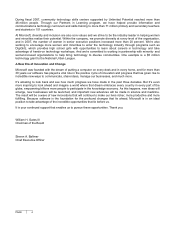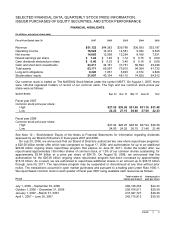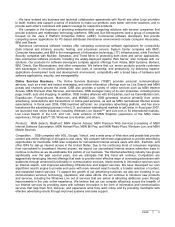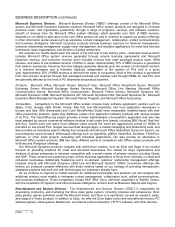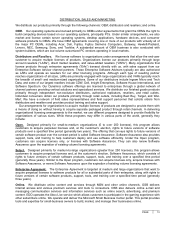Microsoft 2007 Annual Report Download - page 8
Download and view the complete annual report
Please find page 8 of the 2007 Microsoft annual report below. You can navigate through the pages in the report by either clicking on the pages listed below, or by using the keyword search tool below to find specific information within the annual report.
PAGE 7
Special Note About Forward-Looking Statements
Certain statements in this report, other than purely historical information, including estimates, projections,
statements relating to our business plans, objectives and expected operating results, and the assumptions upon
which those statements are based, are “forward-looking statements” within the meaning of the Private Securities
Litigation Reform Act of 1995, Section 27A of the Securities Act of 1933 and Section 21E of the Securities
Exchange Act of 1934. These forward-looking statements generally are identified by the words “believe,” “project,”
“expect,” “anticipate,” “estimate,” “intend,” “strategy,” “plan,” “may,” “should,” “will,” “would,” “will be,” “will
continue,” “will likely result,” and similar expressions. Forward-looking statements are based on current
expectations and assumptions that are subject to risks and uncertainties which may cause actual results to differ
materially from the forward-looking statements. A detailed discussion of these and other risks and uncertainties
that could cause actual results and events to differ materially from such forward-looking statements is included in
the section entitled “Risk Factors” in our fiscal year 2007 Form 10-K. We undertake no obligation to update or
revise publicly any forward-looking statements, whether as a result of new information, future events or otherwise.
BUSINESS DESCRIPTION
GENERAL
Our mission is to enable people and businesses throughout the world to realize their full potential. Since our
founding in 1975, we have worked to achieve our mission by creating technology that transforms the way people
work, play, and communicate. We develop and market software, services, and solutions that we believe deliver
new opportunities, greater convenience, and enhanced value to people’s lives. We do business throughout the
world and have offices in more than 100 countries.
We generate revenue by developing, manufacturing, licensing, and supporting a wide range of software
products for many computing devices. Our software products include operating systems for servers, personal
computers, and intelligent devices; server applications for distributed computing environments; information worker
productivity applications; business solution applications; high-performance computing applications, and software
development tools. We provide consulting and product support services, and we train and certify computer
system integrators and developers. We sell the Xbox 360 video game console and games, the Zune digital music
and entertainment device, PC games, and peripherals. Online offerings and information are delivered through our
Windows Live, Office Live, and MSN portals and channels. We enable the delivery of online advertising through
our proprietary adCenter® platform.
We also research and develop advanced technologies for future software products. We believe that delivering
breakthrough innovation and high-value solutions through our integrated software platform is the key to meeting
our customers’ needs and to our future growth. We believe that we continue to lay the foundation for long-term
growth by delivering new products, creating opportunities for partners, improving customer satisfaction, and
improving our internal processes. Our focus is to build on this foundation through ongoing innovation in our
integrated software platforms; by delivering compelling value propositions to customers; by responding effectively
to customer and partner needs; and by continuing to emphasize the importance of product excellence, business
efficacy, and accountability.
OPERATING SEGMENTS
Our segments provide management with a comprehensive financial view of our key businesses. The segments
provide a framework for the alignment of strategies and objectives across the development, sales, marketing, and
services organizations, and for the timely and rational allocation of development, sales, marketing, and services
resources within businesses. The segments also help focus strategic planning efforts on key objectives and
initiatives across our businesses.
Due to our integrated business structure, operating costs included in one segment may benefit other segments.
Therefore, these segments are not designed to measure operating income or loss that is directly related to the
products included in each segment. Inter-segment cost commissions are estimated by management and used to
compensate or charge each segment for such shared costs and to motivate shared effort. Segments should not
be viewed as discrete or easily separable businesses.
In July 2006, we announced a change in our operating segments reflecting previously announced
reorganizations. We have five operating segments: Client, Server and Tools, the Online Services Business, the
Microsoft Business Division, and the Entertainment and Devices Division. Prior fiscal year information has been
recast to conform to the way we internally managed and monitored performance at the business group level in
fiscal year 2007. See Note 18 – Segment Information of the Notes to Financial Statements for financial
information regarding segment reporting.





